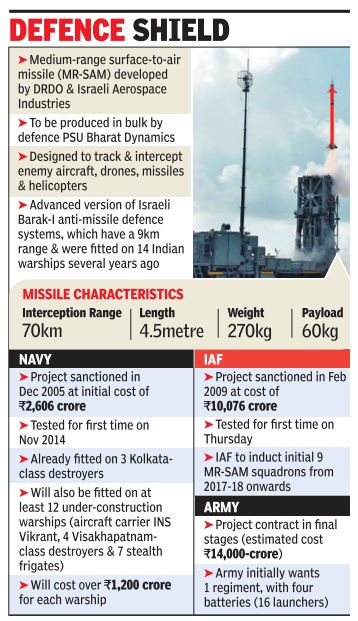Missiles: India

This is a collection of articles archived for the excellence of their content. |
Contents |
Surface-to-air missiles (SAMs)
MR-SAM with multifunction surveillance and threat alert radars
The Times of India, Jul 01, 2016
Rajat Pandit
India took a major step towards plugging some gaping holes in its air defence coverage with the maiden test of a new surface-to-air missile (SAM) system designed to detect, track and destroy hostile aircraft, missiles, helicopters and drones at a range of 70km. The medium-range SAM system, jointly developed by DRDO and Israeli Aerospace Industries, was tested twice against a Britishorigin target drone `Banshee' at the integrated test range at Chandipur-on-sea off the coast of Odisha. The MR-SAM systems with their MF-STARs (multifunction surveillance and threat alert radars) as well as weapon control systems with data links are designed to neutralise multiple targets simultaneously .
IAF will begin inducting an initial nine squadrons of this land-based MR-SAM -at a cost of Rs 10,076 crore -from 2017-18 onwards.
“During the two tests on Thursday, first at 8.15am and then at 3.45pm, the interceptor missiles directly hit the manoeuvring target drones (mimicking enemy aircraft), destroying them. All mission objectives were met successfully,“ Dr G Satheesh Reddy , scientific advisor to the defence minister, told TOI.
While two “profiles“ at different altitudes in the flight envelope were tested on Thursday , the MR-SAM will require a few more tests before its production can kick off next year. While Israel calls the system Barak-8, India is yet to officially name it.
The Navy , incidentally , has already equipped three of its latest Kolkata-class destroyers with the warshipbased version of the MRSAM. The all-weather air defence system, which is being produced by defence PSU Bharat Dynamics (BDL), has also been earmarked for another 12 under-construction warships, including the 40,000-tonne aircraft carrier INS Vikrant.
Intercontinental ballistic missile (ICBMs)
Agni V

Rajat Pandit, Agni-V with China tested in December 2016, Dec 27 2016 : The Times of India


Agni-V , India's most formidable missile with a range of over 5,000 km, is now ready for user trials by the military after it underwent its fourth and final test-firing from the integrated test range off the Odisha coast.
The intercontinental ballistic missile (ICBM), dubbed a “game-changer“ in strategic deterrence because it brings the whole of China and much more within its strike envelope, was fired from its canister on a launcher truck just after 11am.
Powered by three-stage rocket motors, the 50-tonne missile tore into space to a height of 500 km before following its predetermined flight-path to the “splash point“ in southern Indian Ocean 20 minutes later. President Pranab Mukherjee and PM Modi congratulated DRDO. The Agni-V test, monitored by radars and tracking systems, met all the mission objectives. The country has achieved a very high-level of self-reliance in missile technologies,“ said the defence minister's scientific adviser G Satheesh Reddy . Defence minister Manohar Parrikar, among others, congratulated DRDO scientists for the “successful“ test-firing of Agni-V , which is designed to carry a 1.5-tonne nucleartipped warhead.
TOI was the first to re port in its December 14 edition the impending test of Agni-V , which will now undergo at least two user-trials by the tri-service Strategic Forces Command (SFC) be fore full-scale production and induction.
The missile's canisterlaunch final operational version is significant because it gives the armed forces the requisite operational flexibility to swiftly transport and launch the missile from wherever they want within a matter of minutes. The hermetically-sealed canister gives the missile higher reliability , enhanced mobility, less maintenance and longer shelf-life. Some more fireworks are likely again over the Bay of Bengal when SFC conducts user-trials of the 4,000-km Agni-IV , which is also designed with China in mind, in the first week of January. Apart from the shorterrange Prithvi and Dhanush missiles, SFC has inducted the Agni-I (700km), Agni-II (2,000km) and Agni-III (3,000km) missiles till now.
Also in the works is AgniVI, which will be armed with “manoeuvring warheads or intelligent re-entry vehicles“ to defeat enemy defence systems or MIRVs (multiple independently targetable re-entry vehicles). An MIRV payload basically means a single missile is capable of carrying several nuclear warheads, each programmed to hit different targets.